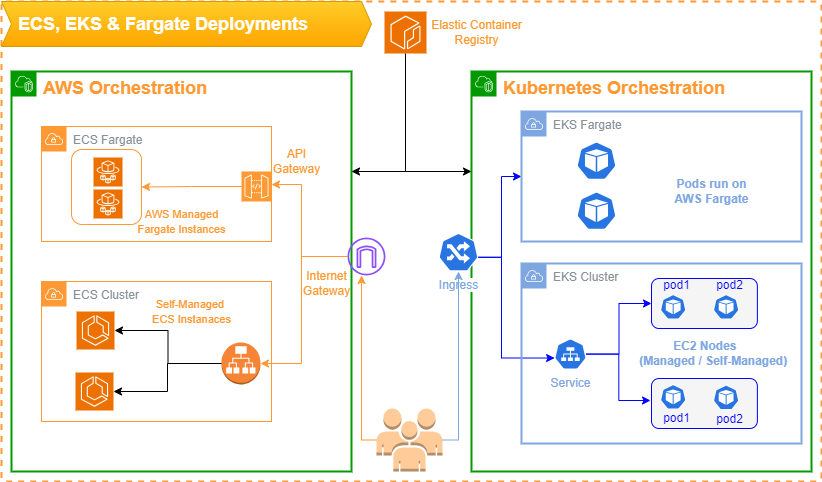ECS vs EKS - Choosing the Right Orchestration Service in AWS
Amazon Elastic Kubernetes Service (EKS) and Amazon Elastic Container Service (ECS) are popular container orchestration tools on AWS.
While both aim to simplify containerized application management, they differ significantly in architecture, scaling, and deployment practices. The choice depends on the level of simplicity and flexibility needs for our workload orchestration.
Before diving into how to choose between the two, let's explore the key differences between these orchestration platforms, which provide valuable insights for making an informed decision.
Key Differences
1. Architecture
While ECS uses AWS-Native orchestration, EKS is a managed Kubernetes environment enabling us to orchestrate our workloads using Kubernetes orchestration.
-
EKS (Kubernetes-Based):
- Deploy workloads as pods using Kubernetes manifests.
- Use Node Groups (managed or self-managed) created via CloudFormation templates for hosting pods.
- Pods can share nodes, leading to optimized resource utilization.
-
ECS (AWS-Native):
- Deploy workloads as tasks using CloudFormation Templates.
- ECS tasks are tightly associated with underlying EC2 instances or Fargate.
- Scaling ECS tasks generally implies scaling EC2 instances (if EC2-backed).

2. Scaling Mechanisms
-
ECS(using EC2 Launch Type):
- In ECS each tasks(the workload instances) runs on it's own EC2 instance in self-managed EC2 launch type.
- ECS task scaling and EC2 scaling are closely coupled and is handled using EC2 autoscalers.
-
EKS(using EKS Cluster):
- In EKS the scaling is handled in two parts :
- Node Scaling: Node groups scale independently, handling the capacity for pod deployments. We can use AWS EC2 auto-scalers or Karpenter, an open-source, high-performance Kubernetes cluster autoscaler.
- Pod Scaling: Use Horizontal Pod Autoscaler (HPA) to scale pods based on metrics like CPU or memory usage.
- Decoupled scaling of nodes and pods allows granular control and better resource efficiency.
- In EKS the scaling is handled in two parts :
-
Scaling Using Fargate:
-
Both ECS and EKS support managed serverless deployment using Fargate.
-
Be it ECS tasks or EKS pods, while using Fargate you need not have to provision, configure or scale your servers. It is taken care by AWS itself, greatly minimizing your operational complexities.
-
3. Vendor Neutrality
-
EKS:
- Underlying Kubernetes in EKS, makes EKS portable across cloud providers or on-premises environments.
- Vendor-agnostic deployments make it ideal for hybrid and multi-cloud setups.
-
ECS:
- ECS orchestration is a AWS-native service, deeply integrated with AWS tools like IAM, CloudWatch, and ALB.
- It is designed to work within AWS infrastructure and does not support easy portability.
4. Resource Utilization
-
EKS:
- Pods can share a node, allowing multiple workloads to run on a single EC2 instance.
- Optimized utilization of compute resources and cost savings for bursty workloads.
-
ECS:
- Each task typically maps to a single EC2 instance (if not using Fargate).
- Less resource-sharing flexibility, potentially leading to higher costs.
5. Operational Complexity
- EKS:
- Highly customizable but complex to set up.
- Requires Kubernetes expertise for managing manifests, pods, and clusters.
- Offers flexibility but increases operational overhead.
- ECS:
- Easier to manage for AWS users with minimal setup.
- Lower learning curve compared to Kubernetes.
- Seamlessly integrates with other AWS services for operational needs such as security, scaling and monitoring.
Choosing the Right Service
-
Choose EKS:
- You need fine-grained control over your cluster and want to leverage Kubernetes advanced features.
- Vendor neutrality and portability across multiple cloud is a priority for your application.
- You have existing Kubernetes expertise or are willing to invest in learning it.
-
Choose ECS:
- Best for AWS-centric workloads or teams seeking simplicity without Kubernetes expertise.
- You prioritize seamless integration with other AWS services or when AWS-native tools suffice.
- Vendor neutrality and portability across multiple cloud is not a priority.
-
Choose ECS\EKS with Fargate:
- Both ECS tasks and EKS pods can use serverless option like Fargate for the ease of use and reducing operational overheads.
- We can choose Fargate for small to medium-sized applications, microservices, and scheduled jobs.
Conclusion
Both EKS and ECS offer powerful container orchestration capabilities on AWS. The best choice depends on your specific needs, technical expertise, and desired level of control and flexibility. The option to go with Fargate deployment can also greatly simplify our operational complexities for the choosen workloads.
By carefully evaluating these factors, you can combine the service and deployment types that best aligns with your application requirements and long-term goals.